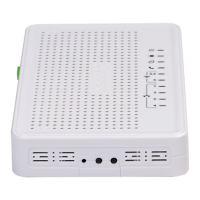____________________________________________________________________________________
____________________________________________________________________________________
NTU Optical Network Terminals 41
– Set WPS AP mode—sets WPS mode of the access point.
Wi-Fi routers supporting the WPS technology have a security vulnerability. This vulnerability allows
attackers to retrieve passwords for WPA and WPA2 encryption protocols. The technology is
vulnerable as it allows to brute-force the 8-digit network key (PIN).
Access point manual configuration:
– Select SSID—selects a name of a wireless network from the list;
– Network Authentication—selects a network authentication mode from the drop-down list:
– Open—wireless network security features are disabled (in this mode, only WEP key can be used);
– Shared—this mode enables user authentication by their SSID or WEP key;
– 802.1x—enables 802.1x standard (enables user authentication with a RADIUS server, WEP key is
used for data encryption);
RADIUS Server IP Address;
RADIUS Port—port number of the RADIUS server The default port is 1812;
RADIUS key—a secret key for access to the RADIUS server.
– WPA2—enables WPA2 (this mode uses WPA2 protocol, requires the utilization of a RADIUS
authentication server);
WPA Group Rekey Interval – the period of time (in seconds) between automatic
changes of WPA encryption keys used to strengthen wireless network security If
you don't need to change encryption keys, enter null value into the field;
RADIUS Port—port number of the RADIUS server The default port is 1812;
RADIUS key—a secret key for access to the RADIUS server;
WPA/WAPI Encryption—selects a WPA/WAPI data encryption method: TKIP+AES,
AES:
– TKIP—the encryption protocol used for WPA It implements a more
efficient mechanism of key change management in comparison with WEP;
– AES—128-bit block encryption algorithm with 128/192/256-bit key,
generally used for WPA2).
– WPA2-PSK—enable WPA2-PSK (this mode uses WPA2-PSK protocol, doesn't require the utilization
of a RADIUS authentication server);
WPA/WAPI Password—a secret phrase. Sets a password; a string of 8-63 ASCII
characters. To view a secret phrase, click ‘Click here to display’ link, and password
will be shown in a pop-up window.
Default network key corresponds to device serial number. Serial number
is printed on a sticker, which is located on device housing.
When changing a password, you have to specify a 10-character
combination. Password should contain numbers and Latin characters in
upper and lower case.
WPA Group Rekey Interval—the period of time (in seconds) between automatic
changes of WPA encryption keys used to strengthen wireless network security If
you don't need to change encryption keys, enter null value into the field.
WPA/WAPI Encryption—selects a WPA/WAPI data encryption method: TKIP+AES,
AES:

